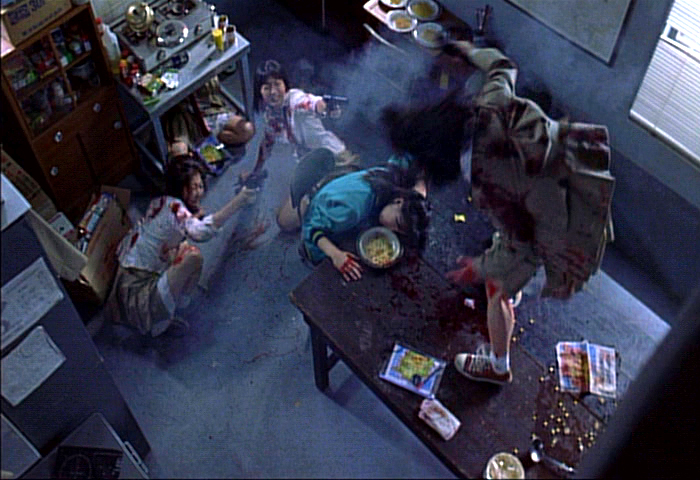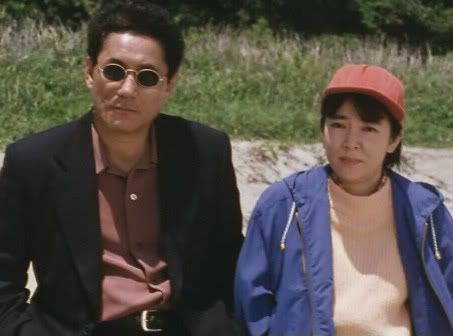 In an era where movies about ocean-liner catastrophes make hundreds of millions of dollars at Christmas, how shall we make a case for an art-film writer-director whose chief claim to fame was being a middle-class soul in anguish? It may be hard to remember now, but thirty-five years ago Michelangelo Antonioni may well have been the most acclaimed filmmaker in the world. It is a spirit that Cinematheque Ontario is clearly out to rekindle in their exhaustive retrospective, Modernist Master: Michelangelo Antonioni.
In an era where movies about ocean-liner catastrophes make hundreds of millions of dollars at Christmas, how shall we make a case for an art-film writer-director whose chief claim to fame was being a middle-class soul in anguish? It may be hard to remember now, but thirty-five years ago Michelangelo Antonioni may well have been the most acclaimed filmmaker in the world. It is a spirit that Cinematheque Ontario is clearly out to rekindle in their exhaustive retrospective, Modernist Master: Michelangelo Antonioni.In a career spanning 16 feature films—he is 85 years of age but apparently at work on another movie—Antonioni’s critical reputation rests for the most part on three he made between 1960 and 1962: L’Avventura, La Notte [The Night], and L’Eclisse [The Eclipse]. These are the movies where he succeeded most completely in the two chores he set for his cinema: to chronicle the breakdown of modern emotional life, and to do so in a way uniquely cinematic and firmly under the control of the director on the set.
From a three-decade remove he looks to have been more successful in the second chore than the first. The critique of modern life running through Antonioni’s work can be summed up in a single phrase: “it won’t work”. The archetypal Antonioni film resembles soap opera for intellectuals who have been unlucky in love: it is full of love affairs that go nowhere and marriages that run on for no reason; people so emotionally delicate that a loud conversation might make them explode, and people so emotionally dead that the explosion probably wouldn’t wake them.
People in Antonioni movies don’t do normal, sensible things—like call the police when they find dead bodies in the park, or refrain from attempting impossible love affairs. They seem beyond rational self-control, as if life to them is just a movie they’re watching, where they are powerless to affect the plot and changing channels is not an option. Antonioni’s characters—and by extension, his idea of most participants in modern life—are quite simply unequipped to properly handle matters of any moral consequence. We merely go through the motions of a moral life, unaware of what we do and unhappy about it.
Introducing his classic L’Avventura to the public at Cannes in 1960, Antonioni was quite explicit about this, speaking of the “heavy baggage of emotional traits which cannot exactly be called old and outmoded but rather unsuited and inadequate. They condition us without offering us any help, they create problems without offering us any possible solutions.”
Thus the main characters in L’Avventura are a man and a woman who become romantically entangled while searching for a missing person: his lover—and her best friend. “It can’t be right. It’s absurd,” cries Claudia. “Good,” Sandro replies. “It’s better if it’s absurd. It means there’s nothing we can do about it.”
Virtually all of Antonioni’s characters are similarly ill-equipped for surviving modern life, if not so similarly forthright about it: In Blow Up, a London fashion photographer whose life is as glossy and as emotionally substantial as a photographic negative is paralyzed with inertia when he realizes he has photographed a murder. L’Eclisse is an apocalyptic version of A Man and a Woman where a couple enters a relationship both know is doomed. In La Notte, a burned-out writer tries to convince himself that he still loves his wife—but his wife knows better.
(You get the feeling that if Antonioni had directed Casablanca, Bogart would have had an adulterous affair with Ingrid Bergman, suffered massive guilt, and then walked into the Atlantic ocean while Paul Henreid and Claude Rains got drunk at Major Strasser’s headquarters. What’s frightening is that it would probably have worked.)
Antonioni’s is a depressing attitude (and not even a particularly original one, reaching back to Neizsche and possibly even to St. Benidict) yet one so beautifully presented that it is utterly convincing—at least while the theatre lights are down. No other director hitches his philosophical wagon so completely to the image he puts on screen, and no other director gets as much benefit from it. A lot of Antonioni’s films look perfect because they look perfect.
It’s that look that stays with you, and it’s intended that way. The images, not the actors, carry the emotional load: what characters do is less important than the spaces the director puts between them. To a viewer raised on the orthodox Hollywood style (i.e., all of us) Antonioni’s camerawork looks self-consciously artsy, almost self-parodying. Yet, look at a still from any of his films, and you know exactly what’s up between his characters.
This is the most elemental communication cinema is capable of and it’s Antonioni’s bread-and-butter. He wants to use film the way we use English; not as a medium for the expression of an idea, (we don’t think up an idea and then express it in language) but with the medium as the idea. The man talks with his camera—what’s up there on the screen is exactly what he’s saying, not describable in terms any more basic than the images. You look, and you understand. (You may have trouble explaining to somebody else what you have understood, but that comes with the territory.)
What he talks about with that camera, in a word, is isolation. His frames are full of empty space, inhumanely and architecturally divided. Streets and public spaces always seem to be empty; his characters alone in the world, isolated for closer observation. People cling unhappily together for comfort against the isolation, fearful of solitude yet unable to handle intimacy. You get the feeling that Antonioni’s ideal film set would be a desert, populated by two people who are afraid to look at one another.
Sooner or later, though, enough alienation is enough. Two decades ago, critic Pauline Kael wrote that she wished Antonioni would, just once, use his talent frivolously—perhaps in a trashy mystery or something.
He came close in 1975’s The Passenger. Here, Jack Nicolson inhabits what for another director would be an action movie scenario: a journalist, sick of his life, trades identities with a dead man he fortuitously resembles. The dead man unfortunately turns out to have been an arms dealer, and dangerous people soon come calling. Things proceed at a very leisurely pace (this is a movie that you can transcribe in longhand as you watch) towards an enigmatic conclusion that makes you wish Antonioni would go even further and do a movie with Bruce Willis—Die Hard: An Outline of Identity.
That not likely being in the cards, we are left with a canon of unmatched seriousness, best taken in moderate doses. At his best (which is often) Antonioni has made films that are beautiful, intellectually challenging, and—provided you are a delicate liberal—emotionally engaging. If they are old news they are at least true news; beautiful artifacts produced by the best eye for cinematic composition since Orson Welles.
How will the hard-nosed 90’s respond? Antonioni might note that all the problems he speaks of are still with us—perhaps even more acutely than ever. On the other hand, easy transcendence seems to be a way of life for us now. If Antonioni were to show up for a press conference in front of CITY-TV tomorrow, the Speaker’s Corner crowd would probably grab him by the shoulders, give him a gentle shake and say, “hey, just get over it, buddy!”
-Published in the Globe and Mail, 1998






